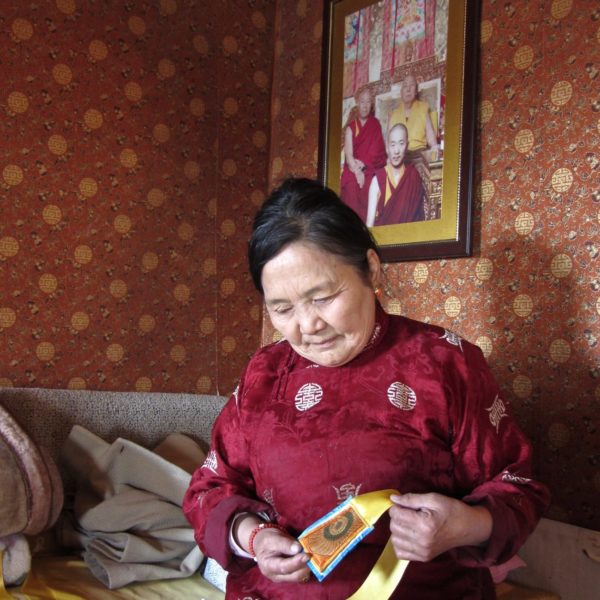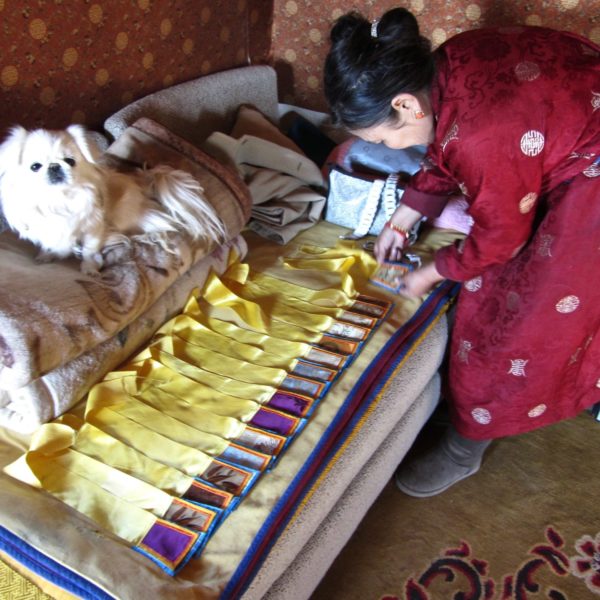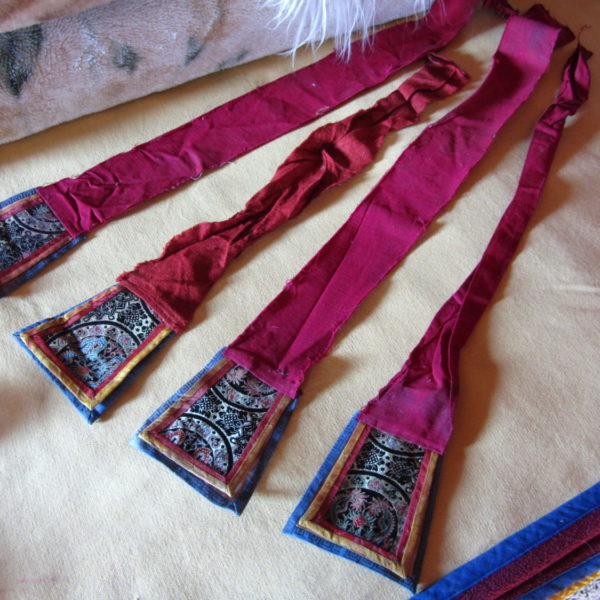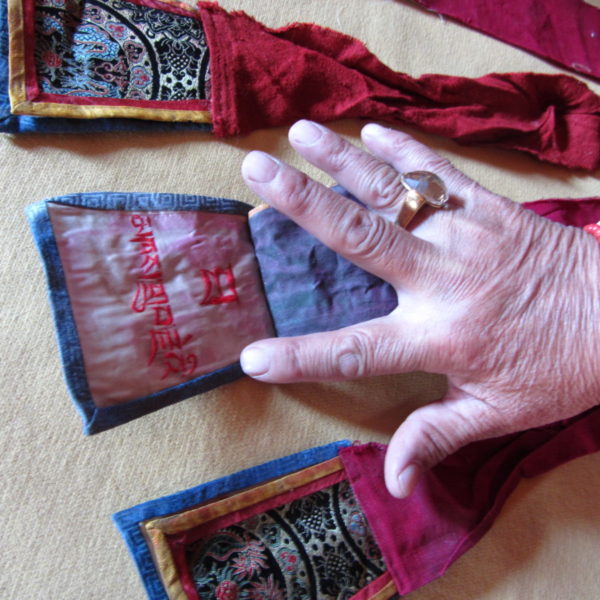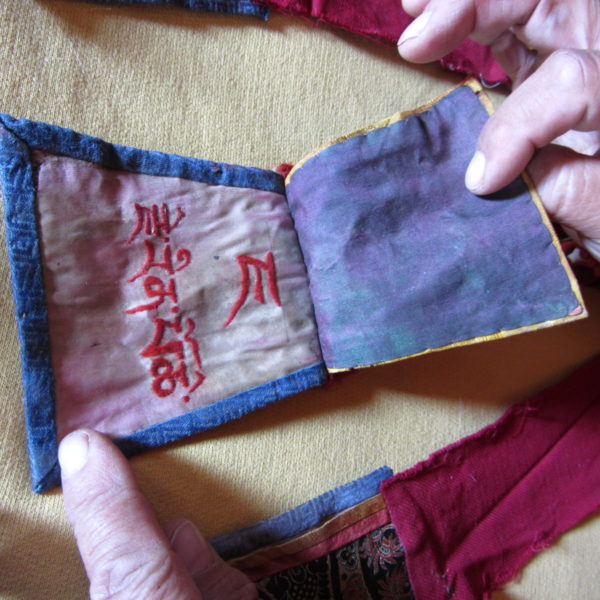During 2010 and 2011, Jantsan Gundegmaa was living in her kitchen-house at Delgeruun Choira in Mongolia’s Dundgovi Aimag overseeing the monastery’s reconstruction whilst Zava Damdin Rinpoche (1976- ) was in his four year solitary retreat. During Mongolia’s long Winter when it is too cold here to work outside, J. Gundegmaa sewed by hand, silk and cotton inserts for pecha, traditional loose-leaf books, that serve an important cataloguing function.
A volume and folio number were allocated to each pecha then returned to the Zava Damdin Scripture and Sutra Institute of Mongolia library’s growing collection. Many of these old texts are rendered by the previous Zava Damdinjav and other Gelug scholars in both Mongol Bichig and the Tibetan language. In this context, a Mongolian woman’s contribution, J. Gundegmaa’s contribution, to revitalising her own lifelong spiritual tradition is by no means just ‘run of the mill’ (i.e. ordinary) needlepoint work.
Pecha
In Mongolia, pecha (Wylie. dpe cha) are traditional loose-leaf books rendered in both Mongol Bichig and the Tibetan language with top and bottom covers made from firm material (e.g. carved wood or cardboard) that are wrapped in silk and/or cotton fabrics for protection. The emphasis is on the use of natural rather than man-made fibres. Traditionally, Buddhist texts, philosophic commentaries and other Vajrayana deity yoga practices (Wylie. sgrub thabs) used to attain spiritual objectives are stored, if not now digitally, in this way.
Delguruun Choira Library in the Gobi Desert 2005
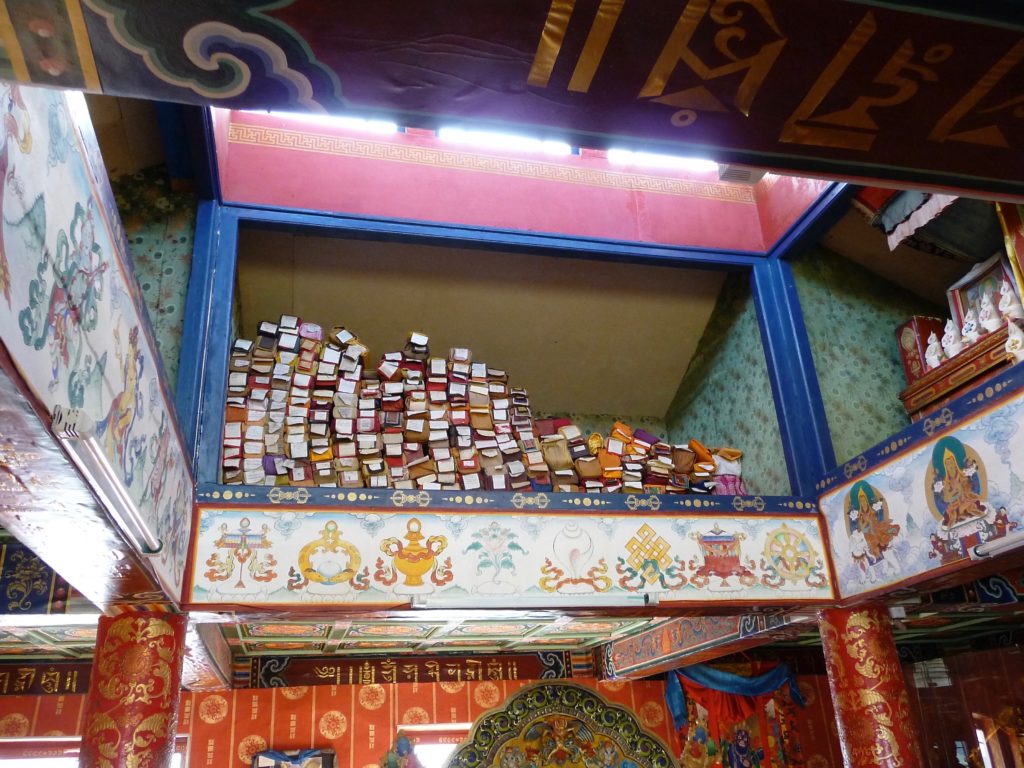
Sutras and other texts stored in The Joyful Temple of Manjushri with other artefacts. Delgeruun Choira in Dundgovi Aimag, Mongolia 23 September 2008. Photograph C.Pleteshner
Although many of the rich textual resources were either destroyed by the soviet socialists, or had simply disintegrated over time beyond salvaging, all the remaining sutras and commentarial texts retrieved by the Abbot and his lams between 2004-2005 were sorted through and rewrapped in the traditional manner using 100% cotton cloth and labelled. The above photograph only shows a small proportion of the texts that were retrieved. By any measure rebuilding the library collection was an enormous task; one that has taken many months if not years.
These retrieved sutras and other authentic texts were then temporarily stored in the upper recesses of The Joyful Temple of Manjushri, along with other precious iconographic artefacs, before being relocated to a more permanent location later on. Many of these texts were composed by the previous Abbot of Delgeruun Choira Zavaa Damdinjav and other Mongol Gelug scholars. It is customary to store precious objects such as these in high places as a sign of respect.
Now some theory: social worlds and the meaning of ‘things’… The British philosopher Horace Romano Harré (2002) proposed that, ‘what turns a piece of stuff into a social object is its embedment in a narrative construction … nothing happens or exists in the social world unless it is framed by human performative activity.’ Drawing on James Gibson’s (1979) notion of `affordance’ theory’,[i] Harré affirms that material things may be disposed towards many different usages and may acquire multiple identities according to different narrative constructions … Objects acquire their full significance only if one takes account of their double role in both the `practical’ order … and the `expressive’ order, which creates hierarchies of honour and status (which enjoys priority over the former). Social life involves symbolic exchanges and joint management of meaning including the meaning of things.
Returning to the Mongolian thread …
Silk brocade ceremonial robes belonging to Mongolian Gelugpa prelates in this community are highly revered. Monastic and ceremonial robes made from cotton (for Summer) and wool (for Winter) are treated with respect too.
Here out in the Gobi, only when threadbare as the result of extensive use, or damaged from tearing, or stained beyond repair from butter-lamp oil or mutton fat are they no longer worn. However, they are never discarded. All material objects here are recycled and put to re-use.
In such instances, small pieces of silk or other fabric are cut from the precious robe and recycled into inserts for pecha covers. In Mongolia such work is carried out only by highly skilled and devoutly religious women[ii] who have been given permission, and as such, are authorised to work with the material.
Each specimen of needlework was being created by hand. For this particular task there wasn’t a soviet era sewing machine in sight. Reflecting a refined domesticity, I watched how J. Gundegmaa sat working on her pecha inserts selecting new and old fabrics from the ceremonial robes of Mongolian Lamas now passed: hand-loomed silk brocades from Varanassi yet with practical function; historical and categorical records with alphabet and numbers herein.
Each pecha cataloguing insert J.Gundegmaa created is a demonstration of diligence and technical sewing proficiency and expertise. Just try making one of these by hand yourself and you’ll soon understand what I mean!
A wide range of Buddhist symbols and motifs had been woven into the design of the silk fabrics now in her care. Reflecting the diligence and precision of a Mongol Gelugpa Buddhist ethos, by selecting certain fabrics with their particular motifs and symbols (instead of others) added another layer of meaning for J.Gundegmaa. I couldn’t help but ask myself: to which prelate or monk did that particular piece of fabric belong? Such discretion! Such deep care and trust! As I sat watching her work, the past was being woven into the present for the next generation. Only Mongolian people who had seen these particular vestments being worn, and knew who was who, carried forward this aspect of the lineage’s knowledge and transmission.
These inserts, although unremarkable to some people, may be seen as objects that incorporate personal, religious and Mongol historical data: cultural markers of both ‘time and place.’ This is also an illustrative example of yet another role that sewing plays in this older generation of contemporary Khalkha Mongol women’s lives and their changing relationship to sewing and needlework from during the socialist era and now on and into ‘post-socialist’ time.
Question: Reflecting on the application of the Trikaya Theory model of analysis outlined in Modes of Contribution, is J.Gundegmaa’s contribution to revitalising her spiritual tradition in Mongolia physical, social of spiritual? In this instance, what do you think?
Acknowledgement
I will forever be grateful to J.Gundegmaa for so generously sharing with me her illuminating Mongolian stories and tales, as we sat together in her kitchen house working on our respective projects; she with her scissors and fabrics and me with my photographs and words.
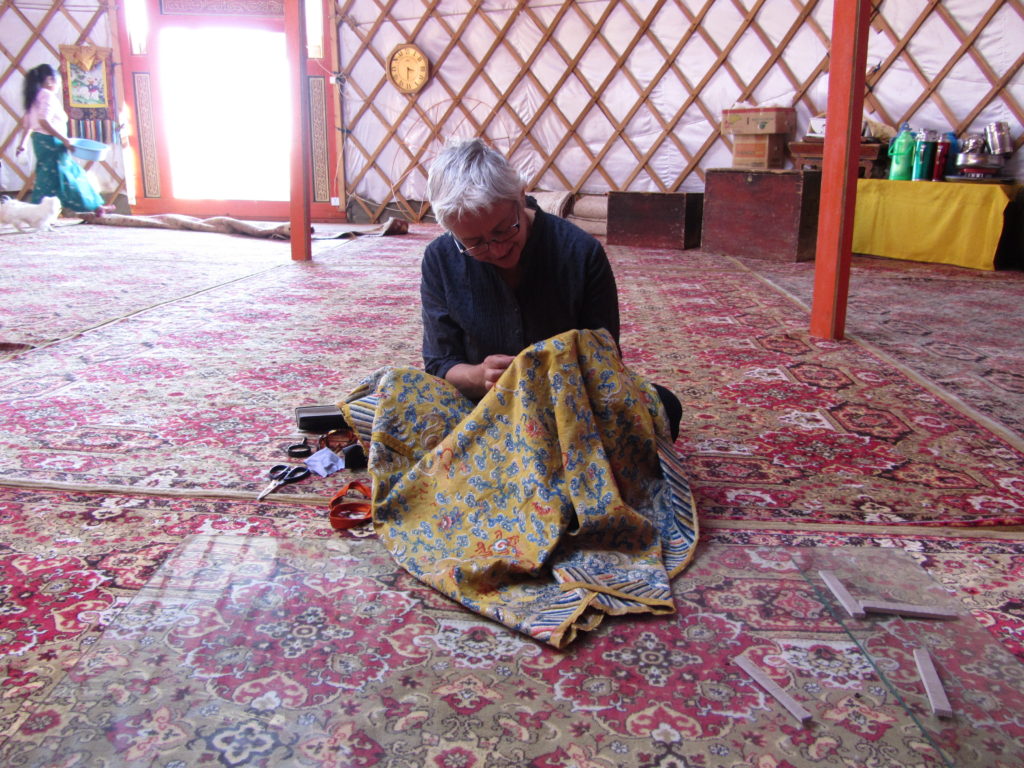
CP mending a traditional silk embroidered parasol. Delgeruun Choira Ger-Gompa, Dundgovi Aimag in Mongolia. 7 October 2011. Photograph by Zava Damdin Rinpoche
For me, sewing with needle and thread is not a cultivated practice! Nonetheless, when Zava Damdin Bagsh requested I turn my hand to repairing a tear in the monastery’s precious Qing Dynasty ritual silk-embroidered parasol, I accepted the challenge to engage in this symbolic task and did the best that I was able.
References
Gibson, James J. 1979. The Ecological Approach to Visual Perception. Boston: Houghton Mifflin.
Harré, Rom. 2002. “Material Objects in Social Worlds.” Theory, Culture and Society19 (5-6):pp23-33.
Stevenson, Mark. 2000. “Wheel of Time, Wheel of History: Cultural Change and Cultural Production in an Amdo Tibetan Community. Unpublished doctoral dissertation.” The University of Melbourne: Australia
Williams, Raymond. 1976. Keywords: a vocabulary of culture and society. Edited by Raymond Williams, Fontana Communications Series. Glasgow: William Collins Sons and Co.
Footnotes
[i] Affordance theory states that the world is perceived not only in terms of object shapes and spatial relationships, but also in terms of object possibilities for action (affordances)— perception drives action. See: https://www.learning-theories.com/affordance-theory-gibson.html. Accessed: 7 July 2019.
[ii] Similarities can be found between such a role with qualities that are valorised with those of possible counterparts in Tibet. Anthropologist Mark Stevenson (2000, p249) in his longitudinal study of Reb gong monasteries in Tibet, and the community within which they are situated, has made the following observations:
“Outside of the [Reb gong] monasteries cooking is women’s work; while men take care of butchering and the preparation of carcasses. They know little else in the preparation of food. [Tibetan] men sew probably as much as Tibetan women do, a skill that is often called upon in the preparation of various buntings in the temples, as well as in the making of clothing for monks and especially sprul sku [Tulkus].”
In contrast, here in Mongolia, being a tailor and sewing is widely considered women’s work; a legacy of 20thCentury Soviet socialist modernisation and social reform.
“A phyor mo (Tib.) or a woman expert at household management is honoured with the respect of her neighbours. Not only is she skilled in the preparation of all kinds of breads and treats or capable in the management of fuel and animals, she may also be sought out to assist in the preparation of the handmade ceremonial garments by families not so well off. A phyor mo should also be religious and engage in charity.”
Here I am assuming that ‘charity’ implies the opposite to ‘a sense of a drying up or freezing of love or benevolence.’ Moreover, it reflects ‘a distance from the [interpersonal] habits and manners of most charitable institutions’ thereby not engendering ‘feelings of wounded disrepect and dignity’ on the part of recipients (Raymond Williams 1976, p46).
This article Artscape 08: Revitalising the social life of material objects was researched and written by Catherine Pleteshner.
Attribution
In keeping with ethical scholarly research and publishing practices and the Creative Commons Attribution 4.0 International License, I anticipate that anyone replicating the images or translating into another language all or part of this article and submitting it for accreditation or other purpose under their own name, to acknowledge this URL and its author as the source. Not to do so, is contrary to the ethical principles of the Creative Commons license as it applies to the public domain.
end of transcript.
Refer to the INDEX for other articles that may be of interest.
© 2013-2024. CP in Mongolia. This post Artscape 08: Revitalising the social life of material objects is licensed under the Creative Commons Attribution 4.0 International License. Documents embedded or linked from this page may be subject to other restrictions. Posted: 7 July 2019. Last updated: 6 January 2023.
